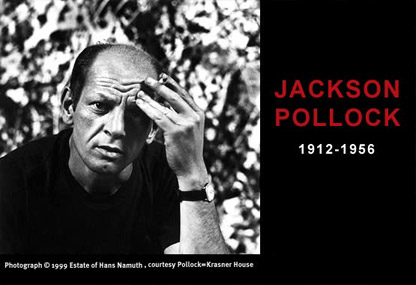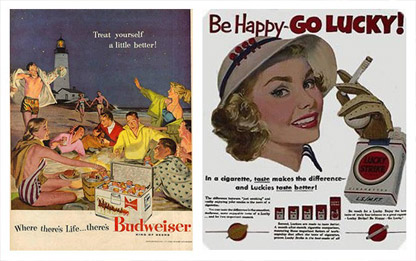Tube paints provide the freedom to paint out-of-doors, formerly, painters mixed pigment in their studios. This no fuss no muss ability is revolutionary to the world of painting; it is the catalyst announcing Modern Art, and the passing of the Renaissance era. A distinctive style and a new technique of painting is born. Beginning with Monet, successive paintings, in this collection, illustrate change and the differences between Modern and Renaissance painters. The London based, Winsor-Newton Company invented and manufacture tube paints. This image is of their first tube paints, 1840 - 1911.
Jackson Pollock (1912 – 1956) hails from the sprawling farmland of Cody, Wyoming. The family copes with the Great Depression by traveling frequently to find work in Arizona, and California.
His mother’s unrealized artistic inclinations propel Jackson to follow his older brother Charles, to New York City. There he studies with a prominent art instructor, Thomas Hart Benton, at the Art Students League of New York, and a figure in the Regionalist art movement.
Although Pollock’s mature style is still developing, he learns how to work in large scale when Peggy, the niece of the founder of the Solomon R. Guggenheim museum, commissions Mural, in 1943. The work measures 247cm. x 605 cm.
By the 1950s Jackson Pollock’s work is acknowledged. Art critic Harold Rosenberg coins the term “action painting” to describe Pollock’s unique style. Time Magazine comes up with the amusing label of “Jack the Dripper.” The artist is considered a phenomenon, regardless of how they experience his work.

Modern, Abstract, Expressionist movement (1940s – 1950s) The Abstract Expressionists represent expatriates from Europe and those who grew up during the Great Depression.
Their art is in response to the horrors of World War II and the anxieties associated with easing of traditional values and adjustments people make after war.
Emergence of TV (for example: The Tonight Show) and integration of professional athletes are huge changes in popular culture. Commercialism is expressed in Billboards, like this one.
The end of the decade sees formation of the United Nations, the “Baby Boom,” and a cosmological model for our universe known as the “Big Bang Theory.”
Most expensive things in the world: painting NO.5, 1948 from Pollock’s “Drip Painting” period, receives the highest sum paid for a painting in an auction. “Why is that Important? Looking at Jackson Pollock.”

Go on to Describe, Analyze, Interpret & Conclude. Contact me for help.
Ocean Greyness 1953. Oil on canvas. 58 x 80 in. (147 x 229 cm.). The emotions, of the Abstract Expressionists, make them the most important artists of the “New York School.” This is not an actual school, but a process adopted to express a variety of intangible ideas. Work is experimental and energetic. Abstract Expressionists break new ground.
After Pollock’s successful run of “Action Paintings,” he returns to figurative images wherein the subjects are recognizable, but not conventionally presented. Ocean Greyness is considered one of Pollock’s last great works. Here you see several disembodied eyes hidden within swirling colored fragments.
San Francisco Museum of Art offers this very interesting video of Pollock actually working and talking about his art in his backyard. The video is entitled “Jackson Pollock Paintings Have a Life of Their Own.”
Do not miss viewing the Scientific Analysis and Conservation of Pollock’s, Mural. Scroll down to see Pollock’s secrets uncovered in the Getty Conservation Institute because Mural strongly influences Pollock’s future paintings.